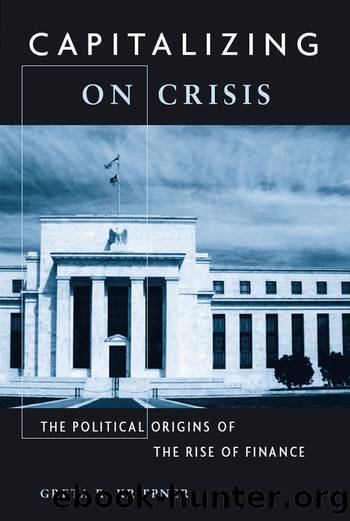Capitalizing on Crisis by Greta R. Krippner

Author:Greta R. Krippner [Krippner, Greta R.]
Language: eng
Format: azw3
ISBN: 9780674066199
Publisher: Harvard University Press
Published: 2012-09-09T16:00:00+00:00
The Evolution of U.S. Monetary Policy: 1979–2001
For many years, central bankers took it as an article of faith that monetary policy could only be effective when the Federal Reserve protected information about its activities from public knowledge (Goodfriend 1986; Greider 1987).11 Most notably, monetarism represented a covert method of policy implementation in which Federal Reserve officials concealed policy choices behind the veil of market forces as drastic action to control inflation became necessary. Given the Federal Reserve’s well-known penchant for secrecy, the gradual shift toward greater policy transparency in the period following the monetarist experiment represents a rather puzzling development. Central bankers’ own explanation of this development revises the conventional wisdom to argue that more open disclosure makes monetary policy more—not less—effective (Blinder 2004; Woodford 2002). In particular, because transparency enables policymakers to credibly commit to objectives, market expectations can be enlisted in pursuit of policy goals. Although this argument is undoubtedly correct, transparency is not merely a technical aspect of policy implementation, but also represents a political strategy that enables policymakers to emphasize some aspects of their activities and not others (cf. B. Friedman 2002).
Thus, if monetary policy has become more effective under transparency, this greater effectiveness reflects the fact that policymakers have managed to avoid becoming embroiled in political contests over their basic objectives and how to best achieve these objectives. Such a situation could hardly be said to obtain at the outset of the period under examination. Paul Volcker’s appointment to the chairmanship of the Federal Reserve in August 1979 occurred at a moment of intense politicization of economic policy, with policymakers struggling to appease both disgruntled consumers and financial markets veering toward panic. It was in this context that Volcker announced his “conversion” to monetarism in October 1979, perhaps the key event in the evolution of monetary policy over the past two decades.
The central claim of monetarism is that the role of the government in stabilizing the economy ought to be limited to ensuring a steady rate of growth of the money supply (M. Friedman 1968). Any other form of government intervention would quickly be “priced in” by omniscient markets, eventually resulting in more—not less—inflation. As such, monetarists argued that rather than narrowly targeting interest rates (the price of money), the Federal Reserve should set its sights on controlling the quantity of money in circulation. Milton Friedman, a key proponent of monetarism, liked to use the following analogy to explain monetary targeting: if the government wanted to control the number of cars produced, it could either set a price for automobiles or it could ration the quantity of steel available in the economy (Greider 1987: 107–108). In the former case, producers would determine how many cars to manufacture based on the mandated price, ordering the appropriate amount of steel to meet this production; in the latter case, the quantity of steel available would guide production, determining the prevailing price. Similarly, the Federal Reserve could contract or stimulate the economy either by controlling interest rates, in which
Download
This site does not store any files on its server. We only index and link to content provided by other sites. Please contact the content providers to delete copyright contents if any and email us, we'll remove relevant links or contents immediately.
The Secret History by Donna Tartt(16627)
The Social Justice Warrior Handbook by Lisa De Pasquale(11489)
Thirteen Reasons Why by Jay Asher(7788)
This Is How You Lose Her by Junot Diaz(5774)
Weapons of Math Destruction by Cathy O'Neil(5038)
Zero to One by Peter Thiel(4824)
The Myth of the Strong Leader by Archie Brown(4789)
Promise Me, Dad by Joe Biden(4449)
Beartown by Fredrik Backman(4419)
Stone's Rules by Roger Stone(4416)
How Democracies Die by Steven Levitsky & Daniel Ziblatt(4399)
The Fire Next Time by James Baldwin(4343)
100 Deadly Skills by Clint Emerson(4079)
A Higher Loyalty: Truth, Lies, and Leadership by James Comey(4033)
Rise and Kill First by Ronen Bergman(4012)
The David Icke Guide to the Global Conspiracy (and how to end it) by David Icke(3883)
The Farm by Tom Rob Smith(3872)
Secrecy World by Jake Bernstein(3783)
The Doomsday Machine by Daniel Ellsberg(3731)
